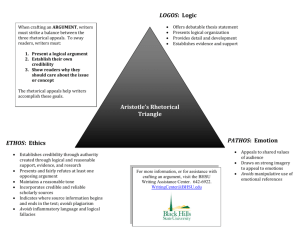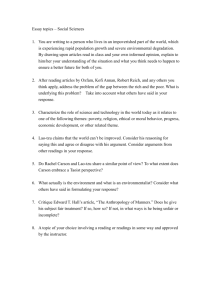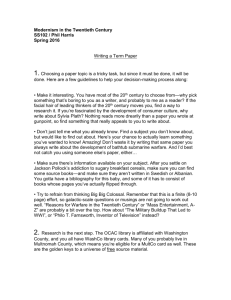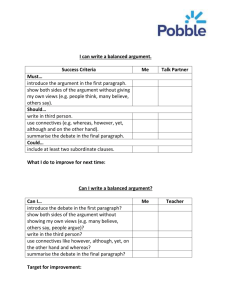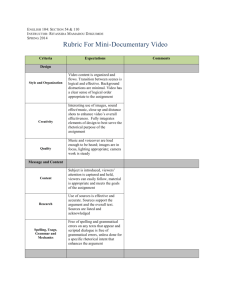Syllabus & Schedule
advertisement
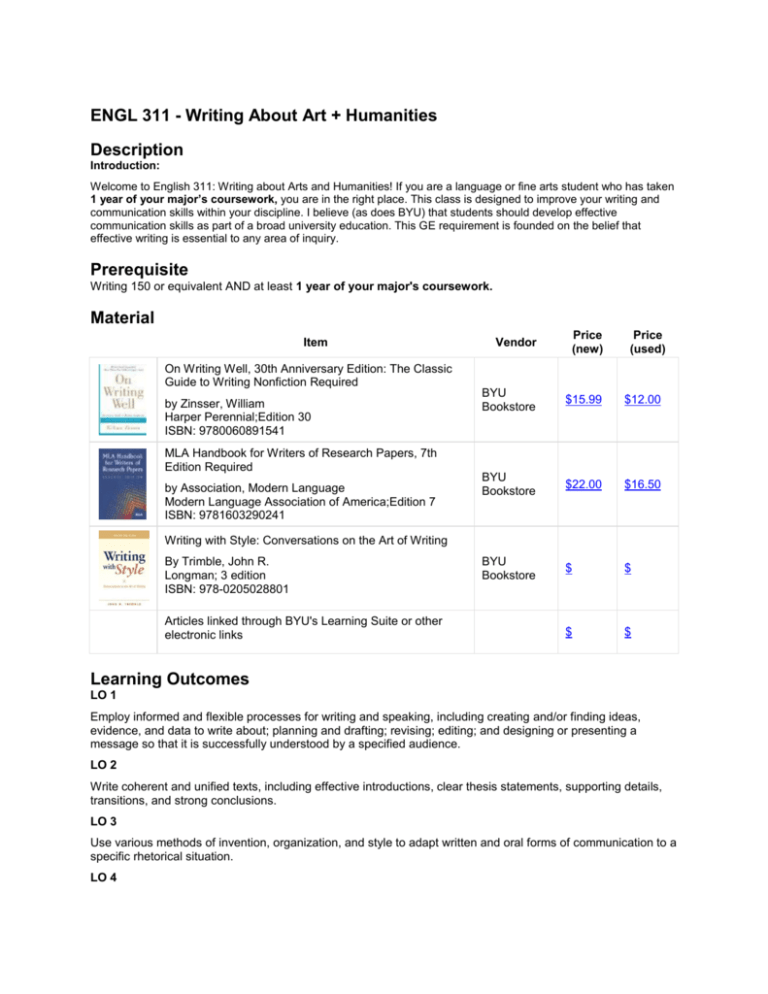
ENGL 311 - Writing About Art + Humanities Description Introduction: Welcome to English 311: Writing about Arts and Humanities! If you are a language or fine arts student who has taken 1 year of your major’s coursework, you are in the right place. This class is designed to improve your writing and communication skills within your discipline. I believe (as does BYU) that students should develop effective communication skills as part of a broad university education. This GE requirement is founded on the belief that effective writing is essential to any area of inquiry. Prerequisite Writing 150 or equivalent AND at least 1 year of your major's coursework. Material Item On Writing Well, 30th Anniversary Edition: The Classic Guide to Writing Nonfiction Required by Zinsser, William Harper Perennial;Edition 30 ISBN: 9780060891541 MLA Handbook for Writers of Research Papers, 7th Edition Required by Association, Modern Language Modern Language Association of America;Edition 7 ISBN: 9781603290241 Vendor Price (new) Price (used) BYU Bookstore $15.99 $12.00 BYU Bookstore $22.00 $16.50 BYU Bookstore $ $ $ $ Writing with Style: Conversations on the Art of Writing By Trimble, John R. Longman; 3 edition ISBN: 978-0205028801 Articles linked through BYU's Learning Suite or other electronic links Learning Outcomes LO 1 Employ informed and flexible processes for writing and speaking, including creating and/or finding ideas, evidence, and data to write about; planning and drafting; revising; editing; and designing or presenting a message so that it is successfully understood by a specified audience. LO 2 Write coherent and unified texts, including effective introductions, clear thesis statements, supporting details, transitions, and strong conclusions. LO 3 Use various methods of invention, organization, and style to adapt written and oral forms of communication to a specific rhetorical situation. LO 4 Utilize the library and electronic resources to locate relevant information, assess its reliability and usefulness, and effectively and ethically incorporate it into their own writing by following an appropriate style of documentation. LO 5 Write in a correct, clear, and graceful prose style. LO 6 Effectively evaluate and comment on the writing of others to facilitate revision. LO 7 Write and speak effectively about the arts to academic and general audiences and for a variety of purposes. LO 8 Critically read and evaluate different artistic mediums as well as scholarship in the humanities. Grading Scale Grade Percent A 0.93% to 100% A- 0.9% to -0.07% B+ 0.87% to -0.1% B 0.83% to -0.13% B- 0.8% to -0.17% C+ 0.77% to -0.2% C 0.73% to -0.23% C- 0.7% to -0.27% D+ 0.67% to -0.3% D 0.63% to -0.33% D- 0.6% to -0.37% E 0% to -0.4% Grading Policy The “A” Paper (90-100%): the “A” paper will astonish me. So, astonish me! The “A” paper has a clear, compelling, kairotic argument supported by effective rhetorical appeals and strategies for the audience selected. Writers use convincing outside authorities to support the argument. Additionally, writers use text and at least two other modes (images, tables, or symbols) to create a convincing, clear ensemble that is both unified and coherent. The writing in the document is appropriate for the audience, grammatically correct, precise, and eloquent—a convincing ethos is established. Punctuation, spelling, mechanics, and other usage reflect the high standards of edited American English. Other modes are blended in effectively to reinforce the argument, present salient information, and connect to readers emotionally. There is a clear arrangement principle at work. Overall, writers use the chosen format appropriately and to its full potential. The “B” Paper (80-89%): the “B” paper has a clear, kairotic argument supported by effective rhetorical appeals and strategies for the audience selected, though there may be minor gaps in the argument or weaknesses in the appeals. Outside authorities are used well enough; they might not be as convincing as others. Writers use text and at least two other modes (like images, tables, or symbols) to create a convincing ensemble that is mostly unified and coherent, though at times the relationship between all the parts or strategies may not be as strong as it should be. The writing in the document is appropriate for the audience and grammatically correct, though ethos may not be distinct or completely convincing. Punctuation, spelling, mechanics, and other usage mostly reflect high standards of edited American English, with few exceptions. Writers use an arrangement principle that is mostly clear. Writers use the format well, if not necessarily to its fullest potential. The “C” Paper (70-79%): the “C” paper has an argument, though that argument may not be completely clear in the document. Writers’ purpose is evident, but the argument is not supported enough to be convincing. Writers may not establish the timeliness of the argument, and outside sources, though used, do not effectively reinforce the claims. The document uses text and at least two other modes, though the document may have too many or too few images to make the point intended. There is an argument present, but the ensemble may not contribute strongly enough to make the argument convincing. The writing in the document is readable, with a few obvious errors in punctuation, spelling, mechanics, and usage that may mar slightly the credibility of the writers. Additionally, the writers may not establish a convincing ethos in the word choice, but the reader can still understand the argument. Overall arrangement might be a bit mysterious. It takes some effort to understand how the writers want readers to experience the argument. Other modes are used, but the connection they have to other parts of the document is weak. Writers make competent—though not necessarily effective—use of the chosen format. The “D” Paper (60-69%): the “D” Paper demonstrates little awareness of the rhetorical situation, and the purpose or position of the writers is not clearly defined. Claims go unsupported, or rhetorical appeals are superficial or unpersuasive. Writers do not use outside sources, or if they do, they’re used without citation or credentials. The writing has glaring errors. Other modes may be used, but they are used ineffectively: e.g., data cannot be read, images are blurry, there is no alignment or arrangement principle at work, the colors clash, the text is illegible, the modes do not reinforce each other, etc. The important information may not accessible. Generally the document looks thrown together. The “E” Paper (0-59%): the “E” paper falls well short of the minimum requirements of the assignment, is plagiarized, or violates a policy established by the instructor. Classroom Policies Participation Policy I believe that each individual brings her or his own gifts, talents, and life experiences to the classroom resulting in each becoming both a student and a teacher. I expect full participation from every class member in order to best facilitate the learning process and I look forward to working with and learning from all of you. Because this is a writing workshop, students should have writing materials with them each class (pen/paper). Also, students should have a printed working draft of the current assignment. I reserve the right to raise or lower a student's final grade based on classroom participation and attitude. Paper Format All of the assignments you turn in for this class must be correctly formatted according to the MLA Style Manual 7th Edition. If you don't know what that means, you're in luck! This is one of the required texts for the course. I expect you to buy it and use it. Communication The best way to know what to do for class is to consult the syllabus. It is your guide to what reading or homework assignments will be due for each class period. However, there will be additional homework assignments given in class. If neither the syllabus nor your classmates can answer your questions, the final course of action is to e-mail me. I will not respond to class emails after six pm or on the weekend. I will also frequently communicate important details about assignments and readings via emails to the entire class, so check your email regularly. Conferences We will meet once for the Cobblestone article and once for the research paper. Conferences are required, and I will not accept your assignment without your having attended them. Also, just because you’ve conferenced a paper with me does not guarantee it an A. Most (if not all) drafts need lots of feedback from several people before they earn an A grade. Writing Center The Writing Center is a free service on campus that offers trained peer tutors to help student writers. I require students take a draft of your research paper to the Writing Center on campus. A failure to go to the Writing Center by the due date—indicate on the syllabus—lowers your paper grade 10%. The one-on-one help from a peer tutor can resolve a lot of problems. When you go, bring a hard copy of your paper. Late Work Assignments are due at the beginning of class on the specified due dates. Late papers will be penalized 10 percent each day. Not each class period—each day. Other assignments (quizzes, library tours, etc.) will not be accepted late. If you have trouble keeping up or have unforeseen extenuating circumstances, talk to me before they become a problem. If you contact me at least 24 hours before the due date, we may discuss the possibility of an extension. Grading Questions I have a 24/7 policy. This means that after you receive a grade, you may not talk to me about that grade for 24 hours. This usually allows students the opportunity to review the task sheet and assignment parameters which answers most of their questions. If you still have questions or concerns, you must talk to me within 7 days of receiving the assignment back. This allows me to have the assignment fresh in my mind. Assignment Descriptions Children's Non-Fiction Article Nonfiction Children’s Article (100 points): The first assignment will plunge you into the writing process: you will write a nonfiction children’s article for a children’s magazine. For this project, you and your peers will research and edit collaboratively to write stellar individual articles. Remember—find your angle and write an argument! Please find your assignment instruction sheet under course content. Résumé and Cover Letter Résumé and Cover Letter (100 points): The second portfolio moves us closer to the professional realm of formal communication. You will write a résumé, cover letter, request for letter of recommendation, and thank you letter for some future, hoped-for employment. We’ll discuss how writing opens doors professionally and how a lack of writing ability can eliminate us from job consideration before we ever get to an interview. Please find your assignment task sheet under course content. Library Tutorial and Session Library Tutorial and Session: You will take the Advanced Writing Tutorial and attend a research session at BYU’s library. You will need to complete the tutorial before our class library session. The link below is the library's page for advanced writing students and includes a link to the tutorial. Library's Advanced Writing Page: http://guides.lib.byu.edu/content.php?pid=415579&sid=3458048 Tutorial: http://net.lib.byu.edu/tutorial/steps/ Assignment: https://byu.qualtrics.com/SE/?SID=SV_6KmIv0XdXfwjUTb Literary Review and Annotated Bibliography Literary Review and Annotated Bibliography (100 points): Our third assignment will prepare you to write your research paper. You will spend time finding and entering your scholarly conversation by researching and identifying both the background and current issues surrounding your topic. Research Paper Rough Draft Upload a digital copy (.doc or docx) of your research paper for originality check. Oral Report Oral Report (50 points): Solving real life problems and success in the workplace can depend as much on verbal communication and an ability to give clear, organized, to-the-point, polished presentations as on writing skills. Throughout the semester, you will have the opportunity to use principles of rhetoric in group and personal presentations. These presentations mimic workplace situations and academic conferences. One of these will be a 6-minute bang-up oral report on your research project. Please see the content tab for task sheet. Research Paper Research Paper (300 points): Our fourth portfolio will hone your scholarly abilities. You will research the scholarly conversation about a relevant topic (within the arts and humanities—specifically within your major) and respond argumentatively to their claims. This is the beast of the semester (an 8-10 page whopper!), though often the most rewarding. Remember—this is an argument! Please find the task sheet under the content tab. You will upload a digital copy of your paper (.doc or .docx) for originality check. Art Review Art Review (100 points): You will write an art (film) review with a popular newspaper/magazine reading public as your audience. You'll find the task sheet and activity packet in the art review section of the content tab. Group Video After writing your art review, you will make a group video with four to five class members that highlights the films you each reviewed. We will watch all class videos at the final. Short Essay Quick Writes Short Essay Quick Writes (2 essays: 10 + 15 = 25 points): These quick writing assignments are designed to promote rhetorical argument skills and are, by their “rushed” nature, less polished than your portfolio writing will be. Nonetheless, they should represent your best thoughts and work. They also help me to diagnose the writing needs of the class. Remember, this is a workshop. You will be sharing your work in class. Please do not write anything that you do not want to share with the class. See Content for task sheets. Attendance, Reading Quizzes, Participation, etc. Reading Quizzes: I would like to award you for reading the assigned material. Thus, on occasion (and at random), we will have short quizzes covering the day’s reading. Many of us discount the benefit reading has on our writing. Good writers read…so complete the reading! Participation is required—I reserve the right to raise or lower a student's grade based on participation and attitude. This grade also reflects students' preparation for class (Did you have copies of what you needed to participate? Did you bring hard copies to class when required? Did you stay on task in groups or talk about other things?) Attendance is also reflected in this grade—fully awake attendance. Final Exam Final Exam: The final exam will be given in our classroom at the university-appointed time. The exam will include a short answer section, a short essay section, and group video presentations. Please note once more that keeping with strictly enforced university policy, absolutely no early or late exams will be given and you will fail the course if you miss the final. Please inform your family immediately and plan travel arrangements, weddings, etc., accordingly. Point Breakdown Assignments Percent of Grade Major Portfolios 30% Children's Non-Fiction Article 10% Résumé and Cover Letter 10% Art Review 10% Research Paper 30% Research Paper Rough Draft 4% Research Paper 26% Addtitional Course Work and Assignments 30% Short Essay Quick Writes 2.5% Library Tutorial and Session 2.5% Literary Review and Annotated Bibliography 10% Attendance, Reading Quizzes, Participation, etc. 7.5% Final Exam 7.5% Oral Reports 10% Oral Report 5% Group Video 5% Extra Credit 0% Class Schedule Date 1 Topics Introduction & Syllabus Readings and Assignments 2 Trimble: "Thinking Well" (3-11) and "Getting Launched" (12-22) Quick Write Essay 1 Zinsser: “The Audience” (24-31) 4 Rhetorical Situations Novice vs. Veteran Audience Rhetorical Arguments Audience, Angle, Purpose, Genre Flow: Cohesion, Coherence, and Focus 5 Voice and Style 6 Introduction to Children’s Article 7 Brainstorming with an Audience, Purpose, Angle, and Genre Cobblestone Visual Rhetoric 3 8 Zinsser: “Simplicity” (6-11), “Clutter” (12-16), and “Unity” (49-53) Zinsser: “The Sound of Your Voice” (231-240) Trimble: “Readability” (58-75) Quick Write Essay 2 Trimble: “Superstitions” (76-87) Children’s Activity 1 Children’s Activity 2 Trimble: “Openers” (23-28) Children’s Activity 3 Trimble: “Revising” (117) Children’s Activity 4 Children’s Article Portfolio 9 Openers 10 Editorial Boards 11 12 Introduction to Professional Unit: Cover Letters and Résumés Genre of Letters: Cover Letter 13 Genre of Letters: Résumé Cover Letter and Résumé Activity 1 Cover Letter and Résumé Activity 2 Cover Letter and Résumé Activity 3 14 Editorial Boards Cover Letter and Résumé Activity 4 15 19 Genre of Letters: Thank You Letters and Email Requests Mock Interviews Peer Review: Thank You Letters and Emails Intro to Research Unit Entering Scholarly Conversations Topics Creating Argumentative Research Creating Research Questions Literary Review and Annotated Bibliography 20 MLA 21 Library Session: MEET IN LIBRARY 22 Research Day: No Class 23 Paper Conferences: No Class 24 25 Introductions So What & Who Cares Claims, Reasons, and Assumptions 26 Cohesion, Coherence, Unity 27 Organizational Methods 28 Editorial Boards Research Activity 5: Full Rough Draft 29 30 Introduction to Oral Presentations and Question Assignment Oral Presentations Trimble: “Odds and Ends” 31 Oral Presentations 32 Oral Presentations 33 Art Review Introduction 34 Class Art Review and Analysis 16 17 18 Cover Letter and Résumé Activity 5 Cover Letter and Résumé Activity 6 Cover Letter and Résumé Portfolio MLA Handbook: “Research Papers” (3-7) Research Activity 1: Brainstorming & Research Questions MLA Handbook: “5.1: Documenting Sources,” “5.2: MLA Style,” “5.3: List of Works Cited” (126-135), “6.1-6.3” (214-218) Complete library tutorial before class MLA Handbook: “Evaluating Sources” (33-38) Research Activity 2 due at conference: Literary Review and Annotated Bibliography MLA Handbook: “Outlining” (41-46) Research Activity 3: Intro & Outline Trimble: “Dramatizing your Ideas” Research Activity 4: Zero Draft 35 Group Assignments 36 Art Review Peer Review 37 Pithy Response Peer Review 38 Group Work 39 Group Work 40 Group Work 41 Exam Prep Art Review Portfolio 42 Final Exam Group Video Art Review Activity 1 Art Review Activity 2 Full Draft of Pithy Piece
